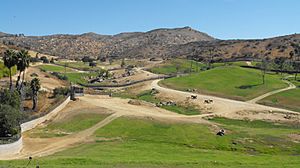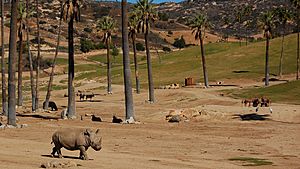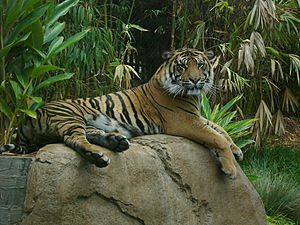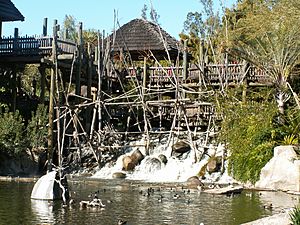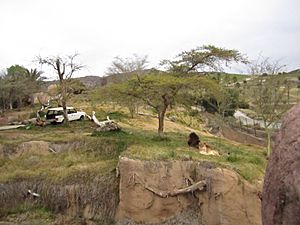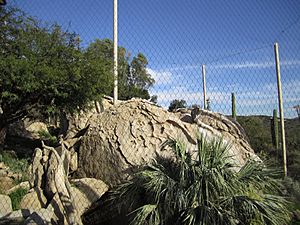San Diego Zoo Safari Park facts for kids
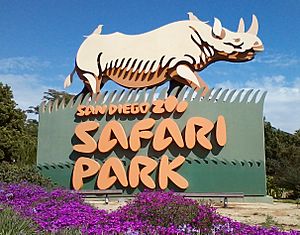
Park entrance sign
|
|
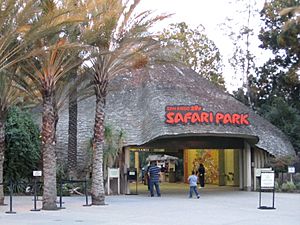
Entrance to the Park
|
|
| Date opened | May 10, 1972 |
|---|---|
| Location | City of San Diego Mailing address: Escondido, California 92027 |
| Land area | 1,800 acres (7.3 km2) (2.8 sq mi) |
| Coordinates | 33°05′59″N 117°00′05″W / 33.099703°N 117.001525°W |
| No. of animals | 3500+ |
| No. of species | 400+ |
| Memberships | AZA |
| Major exhibits | African Plains, African Outpost, African Woods, Asian Savanna, Condor Ridge, Elephant Valley, Gorilla Forest, Hidden Jungle, Lion Camp, Nairobi Village, Tiger Territory |
The San Diego Zoo Safari Park is a huge zoo in San Diego, California. It used to be called the San Diego Wild Animal Park until 2010. This amazing park covers 1,800 acres (about 730 hectares) and is home to many wild and endangered animals.
You can find animals from Africa, Asia, Europe, North and South America, and Australia here. The park is in a dry area, and one of its coolest features is the Africa Tram. This tram takes you on a ride through large open areas where animals like antelopes, giraffes, and rhinoceroses roam freely.
The park is also famous for its California Condor breeding program. This program helps bring back the California condor, a very rare bird, from the edge of extinction. It's the most successful program of its kind in the United States.
About 2 million people visit the park every year. It has over 2,600 animals from more than 300 species. There are also 3,500 different kinds of plants! The park is a major tourist spot in San Diego County, California. It also serves as Southern California's special center for zoo animals coming into the United States.
The San Diego Zoo Safari Park has the world's largest animal hospital. Right next to it is the Institute for Conservation Research, which has the park's "Frozen Zoo." This "Frozen Zoo" stores genetic material to help save endangered animals.
Both the Safari Park and the San Diego Zoo are managed by the Zoological Society of San Diego. The park is about 32 miles (51 km) from the main zoo.
Contents
History of the Safari Park
Starting the Wild Animal Park
The idea for the San Diego Wild Animal Park began in 1964. The San Diego Zoological Society wanted a special place to breed large animals. They needed more space than the main zoo could offer.
The goal was to create a park where animals could live in a natural environment. This was different from traditional zoos with cages. In 1964, they decided to build a "natural environment zoo." Even though it was the most expensive option, it was chosen for its benefits. The first estimated cost was about $1.7 million.
Goals and Opening Day
The main reasons for building this park were:
- To help save different animal species.
- To breed animals for the San Diego Zoo and other zoos.
- To provide natural spaces for zoo animals to live.
They thought about five names for the park. These included San Diego Animal Land and San Diego Safari Land. They finally chose San Diego Wild Animal Park.
The park was supposed to open on April 1, 1972. However, it actually opened a little later, on May 10, 1972. Charles Faust designed the park's layout. It included a big lagoon, a jungle plaza, and an African fishing village. About 50,000 plants were used to make the park look natural.
First Animals and New Arrivals
The first two animals to arrive at the park were the nilgai and the Grant's zebra. The nilgai is an antelope from India. The Grant's zebra has black and white stripes and comes from East Africa.
Other early arrivals included the gemsbok, sable antelope, and greater kudu. They also welcomed white rhinoceroses, which were in danger of disappearing. Ten cheetahs were brought to the park specifically for breeding.
Elephant Conservation Efforts
In 2003, the park helped bring 11 wild African elephants from Eswatini (formerly Swaziland). These elephants were facing danger in their home country. Five of these elephants now live at the Safari Park. They have helped the park's elephant family grow, with 13 babies born by 2013.
In 2012, some elephants moved to the Reid Park Zoo in Arizona. This helped create new elephant herds. The park continues to work on elephant conservation. In 2012, a male calf named Zuli was born. He was the largest elephant born at the park at the time.
Wildfires and Name Change
In October 2007, wildfires affected the park. About 600 acres of natural habitat burned. The park had to close temporarily. Many endangered animals were moved to safety. No animals in the main enclosures were harmed by the fire itself.
On June 30, 2010, the park changed its name. It went from the Wild Animal Park to the San Diego Zoo Safari Park. This change helped people understand that it was part of the San Diego Zoo. The word "safari" highlights the park's large, open areas where animals roam freely.
In July 2019, the park opened the Nikhita Khan Rhino Centre. This new home for six rhinoceroses is named after animal lover Nikhita Khan. Soon after it opened, a rhino named Victoria gave birth to Edward. He was the first rhino in North America born using artificial insemination.
Exhibits and Attractions
The Safari Park has many exciting areas to explore. Each exhibit is designed to look like the animals' natural homes.
Asian Savanna and African Plains
These are the park's biggest exhibits, covering over 300 acres. Here, visitors can see animals from the open plains of Africa and Asia.
- The Asian Savanna is 60 acres. It features animals like Indian rhinoceroses, Bactrian camels, and different types of Asian deer and antelope.
- The African Plains shows animals from many parts of Africa. You can see African buffalo, Rothschild's giraffe, and southern white rhinoceros. There's also a lagoon with many birds like East African crowned cranes.
- The North Africa exhibit has animals from the desert, like scimitar-horned oryx.
- The Southern Africa area is home to Masai giraffes, common eland, and ostriches.
- The Central Africa region has a wooded waterhole. Here you might spot bongo antelope and red river hog.
Tiger Trail
The Tiger Trail is home to the park's Sumatran tigers. These tigers have three different areas to explore. Visitors can watch them through a large glass window. The Tull Family Tiger Trail opened in May 2014. It was built with a lot of support, raising $19.6 million.
In August 2017, a Bengal tiger cub was rescued and brought to the zoo. The oldest female tiger, Delta, passed away in 2020 due to old age. Her daughter, Joanne, is now the main female tiger.
Nairobi Village and Gorilla Forest
Nairobi Village is where you'll find many smaller animals.
- You can see meerkats, ring-tailed lemurs, and Chilean flamingos.
- There's a large bird area and a lagoon with many types of waterfowl.
- The Hidden Jungle, an indoor exhibit, is also here.
- The village has a nursery where you can watch baby animals being cared for. There's also a petting area nearby.
The Gorilla Forest is home to a group of western lowland gorillas. In 2014, a gorilla named Imami gave birth to Joanne, even after having a health issue. In 2019, doctors performed eye surgery on a young gorilla named Leslie. This was the first time such a surgery was done on a gorilla at the park. In 2021, two gorillas here were the first known apes to catch COVID-19 from humans.
Hidden Jungle
The Hidden Jungle is a special indoor exhibit in Nairobi Village. It opened in 1993. This climate-controlled building shows off tropical African birds and insects. You enter through a path that looks like an underground crack. Here, you can see stick insects, spiders, and snakes.
The path then opens into rooms that look like a rainforest. You can see colorful birds like the long-tailed paradise whydah and red-crested turaco. This exhibit is also where the annual Butterfly Jungle event takes place.
Lion Camp
Lion Camp opened in 2004. It's a 1-acre exhibit for the park's six African lions. One side of the area has a big artificial rock hill. It has a 40-foot-long glass window where you can watch the lions. The path continues along a rocky area with acacia trees. There's also a replica observation tent with another viewing window.
Condor Ridge
Condor Ridge features endangered desert animals from North America. The most important animals here are the California Condors. The Safari Park played a huge role in saving these birds. This is one of the few places where you can see them up close.
You can also see desert bighorn sheep and other animals like aplomado falcons, Bald eagles, and desert tortoises.
African Woods and African Outpost
These are two more major exhibits at the park. Visitors walk along a trail that looks like different African habitats.
- African Woods starts with animals from scrublands, like bontebok and different vultures.
- It then moves into a forest area with animals like okapi and red river hogs.
- The path leads to African Outpost, which has plains animals. You can see warthogs, cheetahs, and nyalas. This area has a view of the large African Plains exhibit.
- A central lagoon has lesser and greater flamingos. There's also an island for black-and-white colobus monkeys.
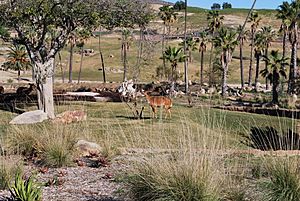
Tours and Rides
The park offers fun ways to see the animals.
- The Africa Tram takes visitors on a ride through the large field exhibits. You can see wildlife from different parts of Africa. This tram uses biofuel, which is better for the environment.
- There's also a tethered balloon ride. This ride lifts visitors 400 feet (about 122 meters) into the air. From up high, you can get an amazing view of the plains exhibits. This ride costs extra.
Gardens
The park also has many beautiful botanical gardens. These gardens are attractions on their own, separate from the animal exhibits. They feature a wide variety of plants.
Walkabout Australia
Walkabout Australia is the park's only exhibit focused on Australia. It covers 3.6 acres. Guests can walk inside an area with western grey kangaroos and red necked wallabies. You can also see different Australian birds like Australian brushturkeys.
This exhibit also has two southern cassowary exhibits. There's a Matschie's tree-kangaroo exhibit and a special area to meet Australian animal ambassadors. Walkabout Australia also has a restaurant. In 2019, a new exhibit called Platypus Pond opened, home to two platypuses.
Conservation Efforts
The Safari Park is a leader in saving endangered animals.
California Condor Recovery
The park played a huge role in bringing back the California Condor. In 1980, they started a special breeding program. They worked with the U.S. Fish and Wildlife Service and the Los Angeles Zoo. By 1987, all 22 remaining wild condors were brought into captivity to breed.
To help them breed faster, the park would carefully remove the first egg laid by a female. This would encourage her to lay a second egg. The first egg would hatch in an incubator. The chick was raised using a condor handpuppet to make sure it didn't get too used to humans. The second egg was raised by the condor parents.
The first condor born this way was Siscouc. Captive-bred condors were released back into the wild starting in 1992. Today, there are over 500 condors, with about 200 living in the wild.
Rhino Conservation and Reproduction
The park has also been important for northern white rhinoceros conservation. Sadly, Angalifu, a 44-year-old male northern white rhino, passed away in 2014. This left only five northern white rhinos in the world. In 2015, the park's last northern white rhino, Nola, also passed away due to health issues.
However, the park continues to work on rhino conservation. In June 2019, two young male African elephants were sent to another zoo. This was part of a plan to help different animal populations grow.
On July 28, 2019, the park announced the birth of Edward. He was a male Southern White Rhinoceros. Edward was the first rhino in North America born through artificial insemination. Another female rhino, Future, was also born this way at the park. These births are very important for the future of rhinos.
The park has also had large elephant births. In 2018, Zuli was born, weighing 299 pounds. Six weeks later, Kaia broke that record, weighing 320 pounds!
Awards and Recognition
The Safari Park has received many awards for its work. These awards recognize its successful breeding programs and efforts to save animals.
| Year | Awarding body | Award | Notes |
|---|---|---|---|
| 1972 | American Association of Zoological Parks and Aquariums (AAZPA) | Edward H. Bean Award | For hatching of Abyssinian ground hornbill |
| 1974 | AAZPA | Edward H. Bean Award | For hatching of Abyssinian ground hornbill |
| 1989 | AAZPA | Edward H. Bean Award | For California Condor breeding (shared with San Diego Zoo and Los Angeles Zoo) |
| 1994 | Association of Zoos and Aquariums (AZA) | Significant Achievement Award | For hornbill breeding program |
| 2007 | Avian Scientific Advisory Group (ASAG) | Plume Award for Noteworthy Achievement in Avian Husbandry | For the Light-footed clapper rail coalition |
| 2011 | USFWS | Endangered Species Recovery Champion Award (Pacific Southwest Region) | Awarded to Michael Mace for work with California condors and light-footed clapper rails |
Images for kids
See also
 In Spanish: San Diego Zoo Safari Park para niños
In Spanish: San Diego Zoo Safari Park para niños


